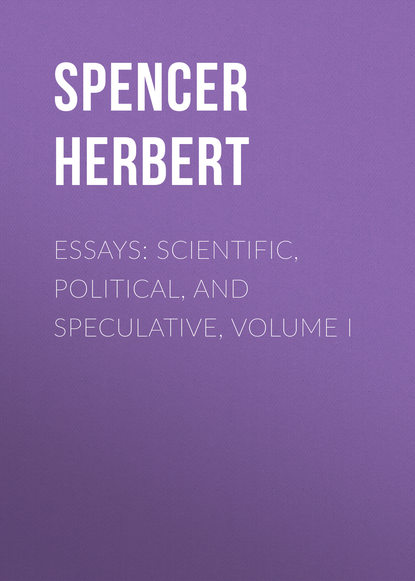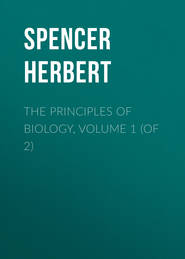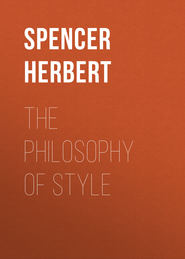По всем вопросам обращайтесь на: info@litportal.ru
(©) 2003-2024.
✖
Essays: Scientific, Political, and Speculative, Volume I
Настройки чтения
Размер шрифта
Высота строк
Поля
At the date of this passage the established teleology made it seem needful to assume that all the planets are habitable, and that even beneath the photosphere of the Sun there exists a dark body which may be the scene of life; but since then, the influence of teleology has so far diminished that this hypothesis can no longer be called the current one.
24
It may here be mentioned (though the principal significance of this comes under the next head) that the average mean distance of the later-discovered planetoids is somewhat greater than that of these earlier-discovered; amounting to 2·61 for Nos. 1 to 35 and 2·80 for Nos. 211 to 245. For this observation I am indebted to Mr. Lynn; whose attention was drawn to it while revising for me the statements contained in this paragraph, so as to include discoveries made since the paragraph was written.
25
If the "rice-grain" appearance is thus produced by the tops of the ascending currents (and M. Faye accepts this interpretation), then I think it excludes M. Faye's hypothesis that the Sun is gaseous throughout. The comparative smallness of the light-giving spots and their comparative uniformity of size, show us that they have ascended through a stratum of but moderate depth (say 10,000 miles), and that this stratum has a definite lower limit. This favours the hypothesis of a molten shell.
26
I should add that while M. Faye ascribes solar spots to clouds formed within cyclones, we differ concerning the nature of the cloud. I have argued that it is formed by rarefaction, and consequent refrigeration, of the metallic gases constituting the stratum in which the cyclone exists. He argues that it is formed within the mass of cooled hydrogen drawn from the chromosphere into the vortex of the cyclone. Speaking of the cyclones he says: – "Dans leur embouchure évasée ils entraîneront l'hydrogène froid de la chromosphère, produisant partout sur leur trajet vertical un abaissement notable de température et une obscurité relative, due à l'opacité de l'hydrogène froid englouti." (Revue Scientifique, 24 March 1883.) Considering the intense cold required to reduce hydrogen to the "critical point," it is a strong supposition that the motion given to it by fluid friction on entering the vortex of the cyclone, can produce a rotation, rarefaction, and cooling, great enough to produce precipitation in a region so intensely heated.
27
Sir Charles Lyell is no longer to be classed among Uniformitarians. With rare and admirable candour he has, since this was written, yielded to the arguments of Mr. Darwin.
28
It may be well to warn the reader against an error fallen into by one who criticised this essay on its first publication – the error of supposing that the analogy here intended to be drawn, is a specific analogy between the organization of society in England, and the human organization. As said at the outset, no such specific analogy exists. The above parallel is one between the most-developed systems of governmental organization, individual and social; and the vertebrate type is instanced merely as exhibiting this most-developed system. If any specific comparison were made, which it cannot rationally be, it would be made with some much lower vertebrate form than the human.
29
A critical reader may raise an objection. If animal-worship is to be rationally interpreted, how can the interpretation set out by assuming a belief in the spirits of dead ancestors – a belief which just as much requires explanation? Doubtless there is here a wide gap in the argument. I hope eventually to fill it up. Here, out of many experiences which conspire to generate this belief, I can but briefly indicate the leading ones: 1. It is not impossible that his shadow, following him everywhere, and moving as he moves, may have some small share in giving to the savage a vague idea of his duality. It needs but to watch a child's interest in the movements of its shadow, and to remember that at first a shadow cannot be interpreted as a negation of light, but is looked upon as an entity, to perceive that the savage may very possibly consider it as a specific something which forms part of him. 2. A much more decided suggestion of the same kind is likely to result from the reflection of his face and figure in water: imitating him as it does in his form, colours, motions, grimaces. When we remember that not unfrequently a savage objects to have his portrait taken, because he thinks whoever carries away a representation of him carries away some part of his being, we see how probable it is that he thinks his double in the water is a reality in some way belonging to him. 3. Echoes must greatly tend to confirm the idea of duality otherwise arrived at. Incapable as he is of understanding their natural origin, the primitive man necessarily ascribes them to living beings – beings who mock him and elude his search. 4. The suggestions resulting from these and other physical phenomena are, however, secondary in importance. The root of this belief in another self lies in the experience of dreams. The distinction so easily made by us between our life in dreams and our real life, is one which the savage recognizes in but a vague way; and he cannot express even that distinction which he perceives. When he awakes, and to those who have seen him lying quietly asleep, describes where he has been, and what he has done, his rude language fails to state the difference between seeing and dreaming that he saw, doing and dreaming that he did. From this inadequacy of his language it not only results that he cannot truly represent this difference to others, but also that he cannot truly represent it to himself. Hence, in the absence of an alternative interpretation, his belief, and that of those to whom he tells his adventures, is that his other self has been away, and came back when he awoke. And this belief, which we find among various existing savage tribes, we equally find in the traditions of the early civilized races. 5. The conception of another self capable of going away and returning, receives what to the savage must seem conclusive verifications from the abnormal suspensions of consciousness, and derangements of consciousness, that occasionally occur in members of his tribe. One who has fainted, and cannot be immediately brought back to himself (note the significance of our own phrases "returning to himself," etc.) as a sleeper can, shows him a state in which the other self has been away for a time beyond recall. Still more is this prolonged absence of the other self shown him in cases of apoplexy, catalepsy, and other forms of suspended animation. Here for hours the other self persists in remaining away, and on returning refuses to say where he has been. Further verification is afforded by every epileptic subject, into whose body, during the absence of the other self, some enemy has entered; for how else does it happen that the other self, on returning, denies all knowledge of what his body has been doing? And this supposition that the body has been "possessed" by some other being, is confirmed by the phenomena of somnambulism and insanity. 6. What, then, is the interpretation inevitably put upon death? The other self has habitually returned after sleep, which simulates death. It has returned, too, after fainting, which simulates death much more. It has even returned after the rigid state of catalepsy, which simulates death very greatly. Will it not return also after this still more prolonged quiescence and rigidity? Clearly it is quite possible – quite probable even. The dead man's other self is gone away for a long time, but it still exists somewhere, far or near, and may at any moment come back to do all he said he would do. Hence the various burial-rites – the placing of weapons and valuables along with the body, the daily bringing of food to it, etc. I hope hereafter to show that, with such knowledge of the facts as he has, this interpretation is the most reasonable the savage can arrive at. Let me here, however, by way of showing how clearly the facts bear out this view, give one illustration out of many. "The ceremonies with which they [the Veddahs] invoke them [the shades of the dead] are few as they are simple. The most common is the following. An arrow is fixed upright in the ground, and the Veddah dances slowly round it, chanting this invocation, which is almost musical in its rhythm:"
"Mâ miya, mâ miy, mâ deyâ,
Topang koyihetti mittigan yandâh?"
"My departed one, my departed one, my God!
Where art thou wandering?"
"This invocation appears to be used on all occasions when the intervention of the guardian spirits is required, in sickness, preparatory to hunting, etc. Sometimes, in the latter case, a portion of the flesh of the game is promised as a votive offering, in the event of the chase being successful; and they believe that the spirits will appear to them in dreams and tell them where to hunt. Sometimes they cook food and place it in the dry bed of a river, or some other secluded spot, and then call on their deceased ancestors by name. 'Come and partake of this! Give us maintenance as you did when living! Come, wheresoever you may be; on a tree, on a rock, in the forest, come!' And they dance round the food, half chanting, half shouting, the invocation." – Bailey, in Transactions of the Ethnological Society, London, N. S., ii., p. 301-2.
30
Since the foregoing pages were written, my attention has been drawn by Sir John Lubbock to a passage in the appendix to the second edition of Prehistoric Times, in which he has indicated this derivation of tribal names. He says: "In endeavouring to account for the worship of animals, we must remember that names are very frequently taken from them. The children and followers of a man called the Bear or the Lion would make that a tribal name. Hence the animal itself would be first respected, at last worshipped." Of the genesis of this worship, however, Sir John Lubbock does not give any specific explanation. Apparently he inclines to the belief, tacitly adopted also by Mr. McLennan, that animal-worship is derived from an original Fetichism, of which it is a more developed form. As will shortly be seen, I take a different view of its origin.
31
Proceedings of the Royal Society of Tasmania, iii., p. 280-81.
32
I have since found, however, that the name Dawn, which occurs in various places, seems more frequently a birth-name, given because the birth took place at dawn.
33
See Prospective Review for January, 1852.
34
His criticism will be found in the National Review for January, 1856, under the title "Atheism."
35
Hereafter I hope to elucidate at length these phenomena of expression. For the present, I can refer only to such further indications as are contained in two essays on "The Physiology of Laughter" and "The Origin and Function of Music."
36
I may add that in Social Statics, chap. xxx., I have indicated, in a general way, the causes of the development of sympathy and the restraints upon its development – confining the discussion, however, to the case of the human race, my subject limiting me to that. The accompanying teleology I now disclaim.
37
Principles of Biology, §§ 159-168.
38
First Principles, second edition, § 97.
39
Principles of Psychology, second edition, vol. i., § 63.
40
Ibid., § 272.
41
It is probable that this shortening has resulted not directly but indirectly, from the selection of individuals which were noted for tenacity of hold; for the bull-dog's peculiarity in this respect seems due to relative shortness of the upper jaw, giving the underhung structure which, involving retreat of the nostrils, enables the dog to continue breathing while holding.
42
Though Mr. Darwin approved of this expression and occasionally employed it, he did not adopt it for general use; contending, very truly, that the expression Natural Selection is in some cases more convenient. See Animals and Plants under Domestication (first edition) Vol. i, p. 6; and Origin of Species (sixth edition) p. 49.
43
It is true that while not deliberately admitted by Mr. Darwin, these effects are not denied by him. In his Animals and Plants under Domestication (vol. ii, 281), he refers to certain chapters in the Principles of Biology, in which I have discussed this general inter-action of the medium and the organism, and ascribed certain most general traits to it. But though, by his expressions, he implies a sympathetic attention to the argument, he does not in such way adopt the conclusion as to assign to this factor any share in the genesis of organic structures – much less that large share which I believe it has had. I did not myself at that time, nor indeed until quite recently, see how extensive and profound have been the influences on organization which, as we shall presently see, are traceable to the early results of this fundamental relation between organism and medium. I may add that it is in an essay on "Transcendental Physiology," first published in 1857, that the line of thought here followed out in its wider bearings, was first entered upon.
44
Text-Book of Botany, &c. by Julius Sachs. Translated by A. W. Bennett and W. T. T. Dyer.
45
A Manual of the Infusoria, by W. Saville Kent. Vol. i, p. 232.
46











